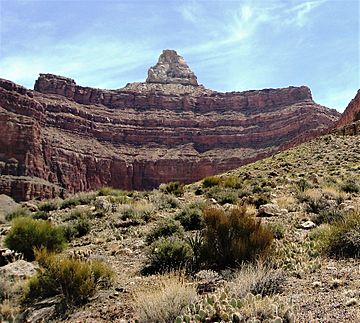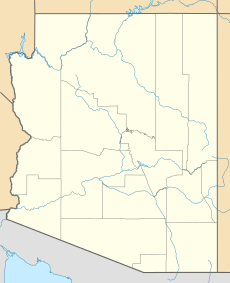Zoroaster Temple facts for kids
Quick facts for kids Zoroaster Temple |
|
|---|---|

Southwest aspect
|
|
| Highest point | |
| Elevation | 7,123 ft (2,171 m) |
| Prominence | 763 ft (233 m) |
| Isolation | 0.88 mi (1.42 km) |
| Parent peak | Brahma Temple (7,551 ft) |
| Geography | |
| Location | Grand Canyon Coconino County, Arizona, US |
| Parent range | Kaibab Plateau Colorado Plateau |
| Topo map | USGS Phantom Ranch |
| Type of rock | Coconino Sandstone |
| Climbing | |
| First ascent | 1958 |
| Easiest route | class 5.7 climbing |
Zoroaster Temple is a huge rock peak in the Grand Canyon, Arizona, USA. It stands 7,123 feet (2,171 meters) tall. You can see it from the South Rim of the canyon, where it towers over 4,600 feet (1,400 meters) above the Colorado River. Its closest tall neighbor is Brahma Temple, which is less than a mile away.
This impressive peak is named after Zoroaster, an ancient prophet from Iran. The names for many Grand Canyon features were chosen by explorers like George Wharton James and Clarence Dutton. Dutton started the tradition of naming these amazing places after gods and figures from old myths. The name "Zoroaster Temple" was officially recognized in 1906 by the United States Board on Geographic Names.
In September 1958, Rick Tidrick and Dave Ganci were the first to climb to the very top of Zoroaster Temple. This was a very important climb because it was the first time anyone had done a "technical climb" in the Grand Canyon. A technical climb means using ropes and special gear to get up steep rock faces. This achievement made the Grand Canyon a popular place for climbers, inspiring many to try and conquer its other peaks. The area around Zoroaster Temple has a Cold semi-arid climate, which means it's usually dry and can have cold winters.
Contents
Grand Canyon Geology: Zoroaster Temple's Layers
The very top of Zoroaster Temple is made of a creamy-colored rock called Coconino Sandstone. This sandstone forms steep cliffs. On top of the sandstone, there are small bits of Kaibab Limestone and Toroweap Formation rock. These rocks are like a cap on the peak.
The Coconino Sandstone is about 265 million years old. It formed from ancient sand dunes that turned into rock over millions of years. Below the Coconino Sandstone, you'll find the Hermit Formation, which forms slopes. Underneath that is the Supai Group.
Even further down, there are layers of Redwall Limestone and the Tonto Group. At the very bottom, near the Colorado River, you'll find the oldest rocks, called the Vishnu Basement Rocks. These are ancient granite rocks. Rainwater that falls on Zoroaster Temple flows south into the Colorado River through nearby canyons.
Tonto Group and Vishnu Basement Rocks
The Tonto Group is a set of three rock layers that sit on a flat area called the Tonto Platform. This platform is part of a famous geological feature called the Great Unconformity in the Grand Canyon. The Great Unconformity is a huge gap in the rock record, meaning a very long time passed where no new rock layers formed, or old ones were eroded away.
The lowest layer of the Tonto Group is the Tapeats Sandstone. This rock forms short, strong cliffs. It touches the even older Vishnu Basement Rocks below it.
Above the Tapeats Sandstone is the thickest part of the Tonto Group, called the Bright Angel Shale. This shale often looks dull green and forms slopes. The third layer, sitting on top of the shale, is the Muav Limestone. This limestone forms a short, strong cliff right below the much larger cliffs of the Redwall Limestone.
Sumner Butte: A Nearby Feature
Sumner Butte is another interesting rock formation near Zoroaster Temple. It's 5,126 feet tall and is located at the end of Zoroaster Temple's long western side. Even though it's not considered a separate mountain because it doesn't rise high enough above the land around it, Sumner Butte has a very striking southwest face.
This face rises over 2,500 feet (760 meters) above Phantom Ranch, a famous spot at the bottom of the Grand Canyon where the Colorado River and Bright Angel Creek meet. Sumner Butte is named after Jack Sumner, who was the main boatman for John Wesley Powell's famous expedition down the Colorado River in 1869.
Images for kids
-
Brahma Temple (left) and Zoroaster Temple (right), from southwest
(Sumner Butte, shaded, in lower left) -
Zoroaster Temple, oil on canvas by Thomas Moran
-
Geologic map showing caprocks of Zoroaster, Brahma, and Deva Temples-Kaibab Limestone upon a thin layer of erodible Toroweap Formation















